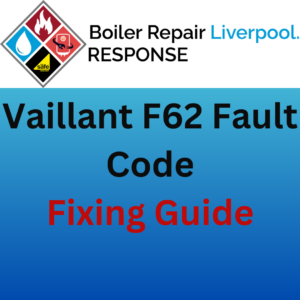You will see the F1 Ideal Boiler Fault Code displayed on your digital display at the front of your boiler Ideal Boilers Logic, Logic Max, and Logic Plus + range.
If you prefer? One of our Response Boiler Repair & Maintenance Experienced Boiler Engineers is on hand, calling us for same-day attendance.
Table of Contents
ToggleWhat Causes of the F1 Ideal Boiler Fault Code
This is caused by the low water pressure inside the heating system of your boiler. Your boiler has gone into lock-out mode and will stop working.
- A leak in the system: If there is a leak somewhere in your heating system, it can lead to a drop in water pressure and trigger the F1 fault code.
- Blocked valves or closed valves: If the central heating valves in your boiler or your central heating system are closed or blocked, they will and can restrict the water flow and result in low pressure.
- Pockets of Air in the system: Air can enter the central heating system through leaks or when bleeding radiators, causing the water pressure to drop and F1 Fault Code to be displayed. Our Engineers can attend the same day in most cases.
- Fault with your pressure gauge: Sometimes the Ideal boiler’s F1 error code may be caused by a faulty pressure gauge, which is in place to give you accurate central heating system water pressure of the water pressure in the boiler.

Checking Your Pressure Sensor
Encountering an F1 fault code signals a common issue: inadequate water pressure in your central heating setup. Fortunately, diagnosing and resolving this problem is straightforward and can be swiftly accomplished.
Begin by locating the pressure gauge, usually situated beneath your boiler. This gauge resembles a watch face and displays pressure levels from 0 to 4.0.
When addressing the F1 fault code, your initial focus should be on the boiler’s pressure gauge. If the gauge falls within the standard range, typically between 1.5 and 2.0, as indicated by the green zone, yet the F1 error persists, the culprit may likely be a malfunctioning pressure sensor.
F1 Ideal Boiler Fault Code Central Heating Gauge Showing Incorrect or Low Pressure
If the pressure gauge reads below 1.0 and dips into the ominous red zone, it’s a telltale sign of an Ideal Boiler F1 error looming. The responsibility to rectify this issue falls squarely on your shoulders.
Low boiler pressure frequently stems from a leak nestled within the intricate web of your central heating framework. This leak could sprout from a myriad of sources, be it within the boiler components themselves, the radiators, or the pipework. Often, corrosion nibbles away at critical components, birthing tiny leaks that tend to cluster around joints.
However, in the absence of an obvious leak, restoring pressure to your boiler is a task well within your grasp, a simple endeavor. Yet, if your system stubbornly sheds pressure, a concealed leak likely lurks, demanding swift resolution.
In such cases, seeking the expertise of one of our Response Boiler Repair & Maintenance Experienced Boiler Engineers is often the prudent course of action. Tackling a leak often necessitates their deft touch, as they may need to reseal or even repipe your system as the situation warrants, after testing and finding the fault.
If the dreaded F1 error code rears its head on your Ideal boiler, fret not. There are a few troubleshooting steps you can take to potentially resolve it:
- Check the pressure gauge: Your first port of call is the pressure gauge on your boiler. Should it register below 1 bar, you’ll need to boost the pressure. If you’re uncertain about how to proceed, it’s prudent to enlist the guidance of a certified gas-safe engineer, the consummate expert in tackling boiler woes.
- F1 Fault Code Ideal Boiler Reset:
- After diligently scouring your system for any discernible leaks and adeptly tweaking the pressure back into the optimal range, the next step is to reset your boiler. Switch it off and then back on after a brief interlude of a few minutes. This straightforward maneuver might just banish the F1 boiler error code for good. Following this simple reset, your boiler should resume its normal operation. As long as the boiler pressure stays within the prescribed range, you should steer clear of any return to the dreaded lockout status.
- F1 Fault Code – Repairing Leaks
- If you find your boiler’s pressure constantly dwindling, even after diligently replenishing it, it’s a sure sign that a leak has infiltrated your heating system. These sneaky leaks often originate from tiny pinholes near joints or arise from the corrosion of crucial system components. Catching them early can spare you the hassle of erratic boiler pressure and potential repair expenses.
- It’s prudent to visually inspect your radiators, pipework, and boiler. Keep an eye out for telltale signs like dripping water or unusual dampness. Nipping these issues in the bud can be instrumental in preventing more severe damage to your heating setup. This ensures its longevity and maintains an efficient and reliable home heating solution.
F1 Ideal Boiler Fault Code Topping Up Boiler Pressure
To rectify the F1 issue and return your boiler to its usual functionality, it’s imperative to normalize the water pressure in your central heating system. While your boiler might not thank you, it will swiftly revert to its regular operations as if the glitch never happened.
Here’s how to go about it, and it’s refreshingly straightforward. Find the filling loop, typically situated just beneath your boiler, often adjacent to the pressure gauge. This filling loop comprises a braided hose affixed with a valve.
Call Response Boilers Liverpool Experienced Trained & Qualified Gas Boiler Engineers
Response Boilers Liverpool are a professional local family-operated boiler repair servicing and new boiler installer in Liverpool. So if you encounter any boiler fault, including the Ideal boiler F1, F2, L2, and F3 fault, don’t panic – seek our professional help. A well-maintained central heating system can save you from the disruption & frustration and inconvenience of no hot water and no central heating with less boiler faults.












